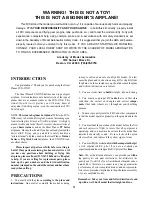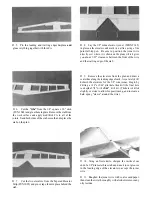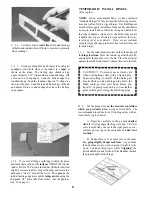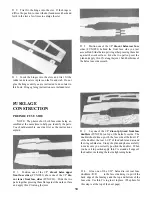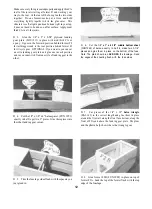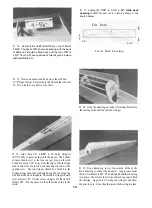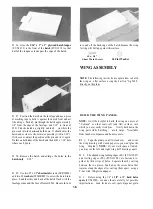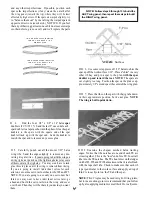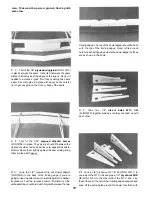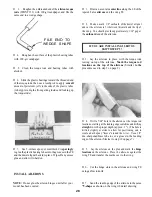
and any other imperfections. If possible, position each
spar so the imperfections (if any) are on the outer half of
the wing panel (toward the tip), where they will be least
affected by high stress. If the spars arc warped slightly, try
to "balance them out" by installing the warped spars in
opposite directions (see sketch). NOTICE: If you feel
that any of the wing parts arc unusable due to severe warps
or other defects, give us a call and we'll replace the parts.
T W O WARPED SPARS INSTALLED
THIS W A Y WILL RESULT IN A
STRAIGHT WING
TWO W A R P E D S P A R S INSTALLED
THIS W A Y WILL RESULT IN A
WARPED WING
D 4. Find ihe four 1/8" x 3/8" x 14" balsa spar
doublers (FUN 1 W 17). Sand the last 2" one end of each
spar doubler to a taper as shown in the photo. Glue the spar
doublers to the spars with the square end of the spar
doubler lined up with the spar end. Sand the doubler to
match the spar and to remove any excess glue.
NOTE: Follow steps 6 through 13 to build the
LEFT wing panel, then repeat these steps to build
the RIGHT wing panel.
Work Surface
D D 6. Use some scrap pieces of 1/16" balsa to shim the
spar up off the work surface 1/16". Place a "shim" in every
other rib bay and pin a spar to the plan with the spar
doubler up and toward the root. NOTE: The spars are
cut slightly too long. Position the spar on the plan so ap-
proximately 1/8" extends past the center of the wing plan.
D D 7. Place the ribs on the spar with the jig tabs down,
in their approximate position, but do not glue. NOTE:
The wing is built upside down.
D 5. Carefully punch out all the die-cut 3/32" balsa
wing ribs. Sand the edges slightly to remove any die-
cutting irregularities. If you are going to build the wing on
a wing jig do not punch out the lightning holes yet as some
of them contain t h e jig holes. You may even have to tack
glue these in place u n t i l the wing is removed from the jig.
If you arc going to install individual servos for each
aileron, cut out me servo rail notches in ribs W4 and W5.
NOTE: If you are going to use only one servo now but
think you may want to have individual servos later, go
ahead and build the servo rails into the wing and cover
over them. Then they will be there if you decide you want
them. 17
D D 8. Examine the shaped, notched balsa trailing
edges. Notice that the notches at one end of each TE arc
closer together. This is the "root" end of me TE. Insert all
ribs into the TE notches. The TE should rest on the ledges
on ribs W3, W6 and W 10 but make sure that it is also flush
with the tops of all ribs. Check to make sure that each rib
is perpendicular to the work surface and apply a drop of
thin CA to each joint on the TE and the spar.
NOTE: Thin CA glue may be used in tight-fitting joints,
but to insure strong joints we recommend that you follow
up by also applying medium or med/thick CA to all joints.
17
Summary of Contents for FUN-ONE
Page 5: ...5...

